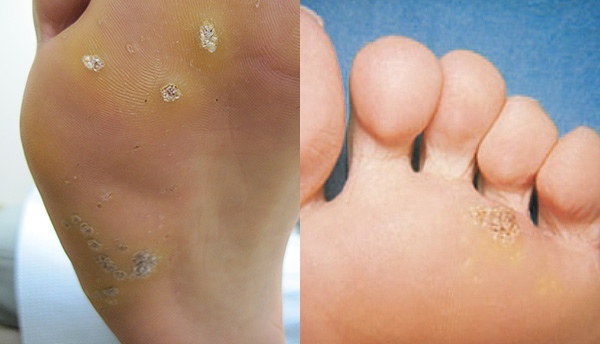Plantar Warts (Verruca Plantaris) are one of several soft tissue conditions of the foot that can be quite painful. They usually occur on the bottom of the foot although occasionally around the sides of digits. Warts are caused by a type of Human Papilloma Virus (unrelated to oral or genital warts), which generally invades the skin through small or invisible cuts and abrasions.

Plantar Warts are common lesions found on the bottom of the foot. It is caused by a viral infection.
If left untreated, a wart can increase in size or one would notice increasing number of warts on the foot over time. They can even appear in your hand. Self treatment of these lesions with over-the-counter medications has mixed results.
Children, especially teenagers, tend to be more susceptible to warts than adults. However, warts in children have a higher tendency to spontaneously resolve on its own without any treatment where as they tend to linger around adults if left untreated.
How Can Warts Be Contracted?
Plantar warts are often contracted by walking barefoot on dirty surfaces or littered ground where the virus is lurking. The causative virus thrives in warm, moist environments, making infection a common occurrence in communal bathing facilities.
Like any other infectious lesion, plantar warts are spread by touching, scratching, or even by contact with skin shed from another wart. The wart may also bleed, another route for spreading.
Tips for Prevention
- Avoid walking barefoot
- Change shoes and socks daily
- Keep feet clean and dry
- Check children’s feet periodically
- Avoid direct contact with warts from another person or from other parts of the body
- Do not ignore growth on or changes in your skin
- Visit your foot doctor as part of your annual health checkup
How Do I Know I Have A Wart?
Plantar warts tend to be hard and flat, with a rough surface and well-defined boundaries. It can be a single lesion on the foot or a cluster of lesions, varying in size and tenderness. Warts often has a center with brownish pinpoint discolorations and skin lines on the bottom of the foot usually diverge around the area.
Often warts are mistaken for corns and calluses or vice versa. Corns and calluses are layers of dead skin that build up to protect an area in which there is increased pressure. It is also possible for a variety of more serious lesions to appear on the foot, including malignant lesions such as carcinomas and melanomas. Although rare, these conditions can sometimes be misidentified as a wart and require urgent workup and treatment. It is important to consult a doctor when any suspicious growth or eruption is detected on the skin on the foot in order to ensure a correct diagnosis.
Treatment
Self treatment is generally not advisable. Over-the-counter preparations contain acids or chemicals that destroy skin cells, and it takes an expert to destroy abnormal skin cells (warts) without also destroying surrounding healthy tissue. Self treatment with such medications especially should be avoided by people with diabetes and those with cardiovascular or circulatory disorders. Never use them in the presence of an active bacterial infection.
You should seek medical evaluation and treatment if you believe you have a wart to obtain proper care and prevent worsening of the condition. Our doctor has a variety of treatment options available for our patients including topical and oral treatments. Very rarely and in severe cases in which the wart is resistant and has failed multiple therapies, the doctor may consider surgical excision of the wart. Selection of treatment depends on the doctor’s thorough assessment of you overall medical health, nature of the wart such as size and location, and how many lesions are involved.

